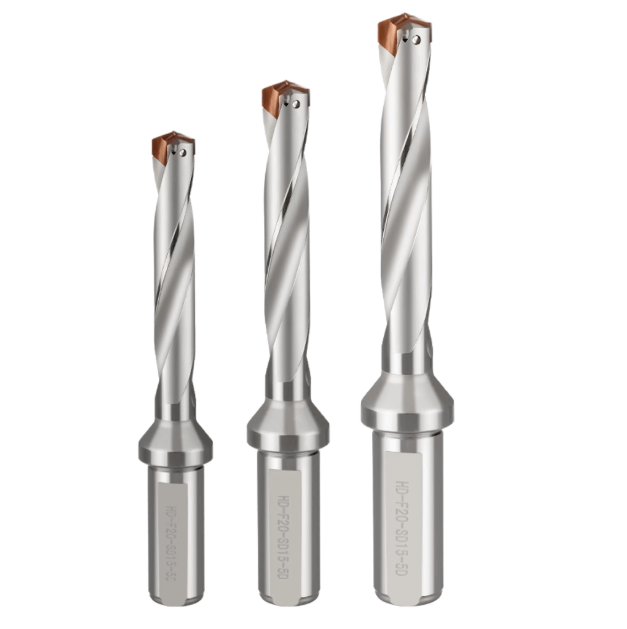Surface finish is a critical concern in high-precision 3D machining. Choosing the right radiused end mill reduces tool marks and step marks, extends tool life, and improves machining efficiency. Carbide radiused end mills offer superior wear resistance and cutting stability, making them ideal for high-hardness materials.
For deep cavities or complex curved surfaces, long reach radiused end mills provide high-precision access while minimizing vibration and surface roughness. Additionally, custom radiused end mills allow flexible tool radius and geometry adjustments for specialized or non-standard workpieces, ensuring reliable and efficient machining.
When combining roughing and finishing strategies, selecting the best radiused end mill for roughing and finishing achieves optimal 3D surface quality while maintaining productivity. This article explores the benefits of radiused end mills across tool types, machining parameters, and real-world applications.
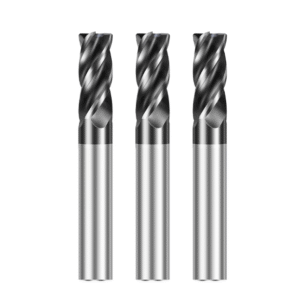
Selecting the Right Radiused End Mill to Improve 3D Surface Quality
Tool selection directly impacts machining efficiency, surface smoothness, and tool life in 3D surface machining. Radiused end mills with their nose radius design reduce step marks and cutting impact, enhancing surface smoothness. Choosing the right type, radius, and material is essential for mold manufacturing, aerospace components, or high-precision mechanical parts.
Carbide radiused end mills are ideal for high-hardness materials, maintaining stable cutting and long tool life. Long reach radiused end mills enable precise machining in deep cavities or narrow areas while reducing surface roughness caused by vibration. Custom radiused end mills address non-standard geometries, allowing efficient, stable, and smooth 3D machining.
Impact of Workpiece Material on Tool Selection
Workpiece hardness, toughness, and cutting characteristics dictate tool selection strategies. Soft metals like aluminum or copper benefit from carbide radiused end mills with moderate radii for fast cutting and reduced surface galling. Hard materials, including steel, cast iron, or carbide, require high wear resistance and stable cutting edges to prevent chipping and scratches.
Thermal sensitivity and cutting chemistry also influence tool choice. High-temperature alloys are prone to adhesive wear, necessitating coatings or custom radiused end mills for better surface quality and extended tool life.
Optimizing Corner Radius in Roughing and Finishing
The nose radius affects roughing and finishing differently. During roughing, a larger radius enhances tool strength, stability, and vibration resistance. During finishing, a smaller, optimized radius ensures surface detail and smoothness.
Proper allocation of tool radius and cutting parameters minimizes stair-step marks and scratches, maximizing tool life and producing ideal 3D surfaces.
Optimal Radiused End Mill Parameter Settings for Roughing and Finishing
Choosing the best radiused end mill for roughing and finishing requires considering tool diameter, nose radius, depth of cut, feed rate, and spindle speed. During roughing, prioritize efficiency and stability with carbide radiused end mills. For finishing, carefully control depth and feed to minimize surface roughness, ensuring long-reach end mill stability in deep cavities.
Custom radiused end mills can fine-tune radius and geometry for specific curved surfaces, further improving surface finish and machining efficiency. Proper settings maximize tool life and ensure high-quality 3D parts.
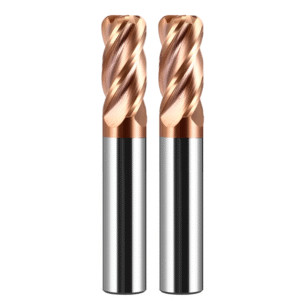
Performance Advantages of Carbide Radiused End Mills
Carbide radiused end mills offer significant advantages in precision 3D machining, especially for hard materials and complex curved surfaces, effectively improving surface finish. Compared to traditional high-speed steel tools, carbide provides superior wear resistance and rigidity, allowing the tool to maintain its shape during high-speed cutting and long machining operations. This reduces the risk of chipping and scratching. Combined with optimized geometry and coating technology, these tools improve machining efficiency and extend tool life.
In 3D machining of molds, aerospace components, and precision mechanical parts, carbide radiused end mills enable integrated roughing and finishing, minimizing stair marks and surface galling, making them ideal for improving surface quality and productivity.
Mechanisms of Improved Wear Resistance and Tool Life
The wear resistance of carbide radiused end mills comes from the high hardness of the material and optimized microstructure. During cutting, friction and heat at the tool edge directly impact tool life. Carbide substrates withstand high temperatures and cutting forces, reducing edge wear. The radiused tip further distributes cutting stress and minimizes the risk of chipping.
Choosing the appropriate coating type (e.g., TiAlN, AlTiN) and tool radius further enhances wear resistance, ensuring stable performance during long, continuous machining. This consistency supports accurate and smooth 3D surface machining.
Stability and Cutting Force Analysis of Carbide Radiused End Mills
In hard material machining, cutting forces affect both surface quality and tool life. Carbide radiused end mills, with high rigidity and stable edge geometry, reduce vibration and tool runout, minimizing scratches and chatter marks.
For deep cavities or complex surfaces, the stability of long reach radiused end mills is critical. Optimizing cutting parameters—spindle speed, feed rate, and depth of cut—balances cutting forces and tool wear, ensuring the desired surface finish and geometric accuracy.
Impact of Coatings and Tool Geometry on Surface Finish
Coatings and tool geometry strongly influence 3D surface quality. Appropriate coatings improve wear resistance and reduce cutting friction and chip adhesion, minimizing tool marks and stair-step marks.
Tool geometry, including corner radius, cutting edge angle, and helix, affects cutting smoothness. Optimized geometry distributes cutting stress, reduces surface roughness, and ensures finishing quality. Custom radiused end mills can further tailor geometry to the workpiece, improving both surface finish and machining efficiency.
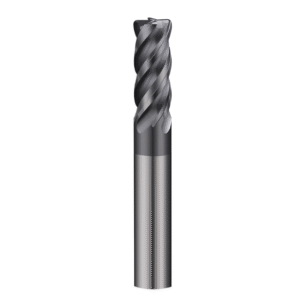
Application of Long Reach Radiused End Mills in Complex Surface Machining
Long reach radiused end mills enable precision machining in hard-to-reach areas for deep cavities and complex curved surfaces. Their extended reach allows stable contact and precise path control, reducing vibration and improving surface finish.
These tools are essential for aerospace, automotive molds, and high-precision mechanical parts. Optimized cutting strategies improve efficiency, reduce tool marks, step marks, and burrs, and provide reliable support for high-precision 3D machining.
Advantages in Deep Cavity and Tall Mold Machining
Long reach radiused end mills access deep cavities and tall molds, solving areas unreachable by standard tools. A proper tool length-to-diameter ratio prevents interference while maintaining cutting path integrity and smooth surfaces.
The radiused corners help disperse cutting stress, reducing vibration and improving accuracy. This is crucial for aerospace molds, precision injection molds, and complex mechanical components.
Vibration Control and Tool Stability Optimization
Vibration greatly affects surface quality and tool life. Controlling feed rate, depth of cut, and spindle speed reduces vibration during deep cavity machining.
Selecting rigid, geometrically optimized tools (like carbide long reach radiused end mills), combined with stable fixturing and path optimization, ensures smooth cuts on curved surfaces, minimizing step marks and micro marks.
Selecting Proper Extension Length and Diameter for Long Reach Radiused End Mills
The tool length-to-diameter ratio is critical. Too long causes vibration; too short limits reach. Engineers should choose diameter and extension based on depth, surface complexity, and machine rigidity. Custom radiused end mills provide tailored solutions for efficient, smooth machining of complex surfaces.
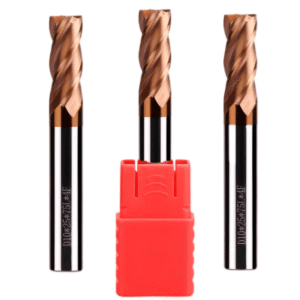
Custom Radiused End Mills Meet Special Machining Needs
In 3D surface machining and complex part processing, standard radiused end mills may not meet unique workpiece geometries or non-standard machining requirements. Custom radiused end mills provide optimal solutions by adjusting tool tip radius, diameter, extension length, and cutting edge geometry.
These customized tools are suitable for deep cavities, tall molds, or complex curved surfaces. They improve surface finish and machining stability in demanding applications, such as hard material machining and precision mold processing. Combined with optimized cutting parameters and toolpaths, custom radiused end mills can effectively reduce step marks, scratches, and micro burrs, achieving high-precision and high-efficiency machining.
Customized Radiused End Mills for Complex Surfaces and Non-standard Parts
Industries such as aerospace, automotive molds, and medical devices often feature parts with complex curves or non-standard dimensions. Standard tools may fail to meet these requirements. Custom radiused end mills allow tool geometry to be tailored to surface radius, cavity width, and part height, ensuring stable contact during cutting and avoiding vibration or tool interference.
Examples include:
-
High-precision aerospace turbine blade machining
-
Complex injection mold cavity machining
-
3D surface finishing of high-hardness steel components
These tools ensure smooth and precise surface machining while improving processing efficiency.
Productivity and Surface Quality Improvements with Custom Radiused End Mills
Custom radiused end mills optimize tool nose radius, helix angle, and length based on part characteristics, resulting in smoother cutting and reduced cutting impact and vibration. This enhances surface finish, shortens cycle times, and allows integrated roughing and finishing.
Using custom tools reduces tool changes and downtime caused by wear or chipping, improving overall productivity. Optimized tool designs also reduce the need for subsequent polishing or finishing operations, lowering overall processing costs.
Cost-Benefit Analysis of Custom Radiused End Mills
Although the initial cost of custom radiused end mills is higher than standard tools, they provide long-term benefits in machining complex surfaces, deep-cavity parts, and precision hard materials. Reduced machining time, improved surface finish, and extended tool life result in higher productivity and lower unit costs.
Engineers should evaluate part complexity, batch size, and precision requirements, developing tooling plans that balance cost and benefit to maximize ROI.
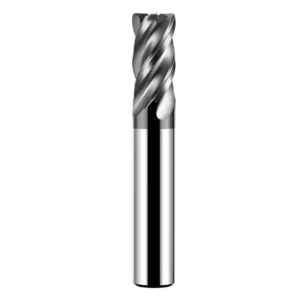
Machining Strategies and Tool Parameter Optimization Improve Surface Finish
In 3D surface machining, relying solely on high-performance tools is insufficient for achieving optimal surface quality. Appropriate machining strategies and refined tool parameter optimization significantly reduce step marks, scratches, and surface roughness, improving overall machining efficiency.
By combining the characteristics of carbide radiused end mills, long-reach radiused end mills, and custom radiused end mills, engineers can balance roughing and finishing while ensuring smooth surfaces on complex curved surfaces and deep cavities.
Impact of Cutting Parameters on 3D Surface Finish
Cutting parameters—feed, speed, and depth of cut—directly affect surface quality. High feed rates may cause vibration and rough surfaces, while low feed rates reduce efficiency. Matching spindle speed with tool diameter and nose radius ensures smooth cutting and reduces step marks.
Cutting depth should consider material hardness, tool rigidity, and tool type (e.g., best radiused end mill for roughing and finishing) to ensure surface quality and tool life. Properly controlling cutting depth and speed reduces peak forces, minimizes tool wear, and prevents thermal deformation in hard material machining.
Toolpath Optimization and Stock Allocation Strategies
Toolpath design significantly impacts surface smoothness and machining efficiency. Strategies like constant-depth cutting, spiral cutting, or layered cutting evenly distribute cutting loads, reducing vibration and step marks.
Stock allocation is also critical. Leaving appropriate stock during roughing provides a stable foundation for finishing, while minimal stock during finishing improves surface smoothness and detail accuracy. Custom radiused end mills can further enhance results by optimizing tool geometry for specific surfaces.
The Role of Cooling and Lubrication in 3D Machining
Cooling and lubrication reduce tool and workpiece temperatures, slow tool wear, and improve chip evacuation, contributing to better surface finish.
High-pressure cooling, mist cooling, or oil-based lubricants can reduce friction and vibration during high-speed cutting or deep cavity machining with carbide radiused end mills. Proper selection of cooling methods prevents thermal deformation and ensures surface smoothness and geometric accuracy in high-precision machining.
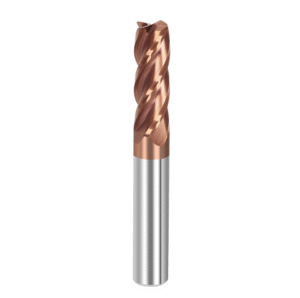
Surface Quality in 3D Machining Can Be Significantly Improved by Selecting and Optimizing Radiused End Mills
Surface finish in 3D machining depends not only on machine tool accuracy and process but also on selecting and optimizing radiused end mills. Different types offer unique advantages:
-
Carbide radiused end mills: High rigidity and wear resistance maintain stable cutting forces, reduce tool wear, and improve surface smoothness.
-
Long reach radiused end mills: Ideal for deep cavities and tall molds; optimized cutting parameters and toolpaths control vibration and maintain surface quality.
-
Custom radiused end mills: Flexible solutions for complex surfaces and non-standard parts; adjusting tool tip radius, geometry, and extension length improves efficiency and surface finish.
Engineers should develop machining strategies based on tool type, workpiece material, and machining stage. Optimizing cutting parameters, toolpaths, and stock distribution, along with appropriate cooling and lubrication, can further enhance surface quality and productivity. Selecting the best radiused end mill for roughing and finishing ensures optimal surface finish while maintaining machining efficiency and reducing finishing costs.
Scientific selection and optimization of radiused end mills significantly improve 3D surface quality and provide a stable, efficient, and controllable machining process, making them essential for high-precision parts.





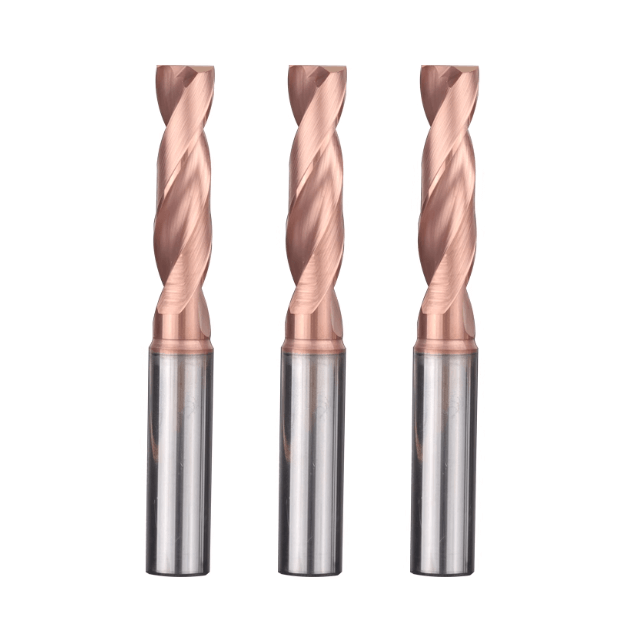

-白底主图2.jpg)
